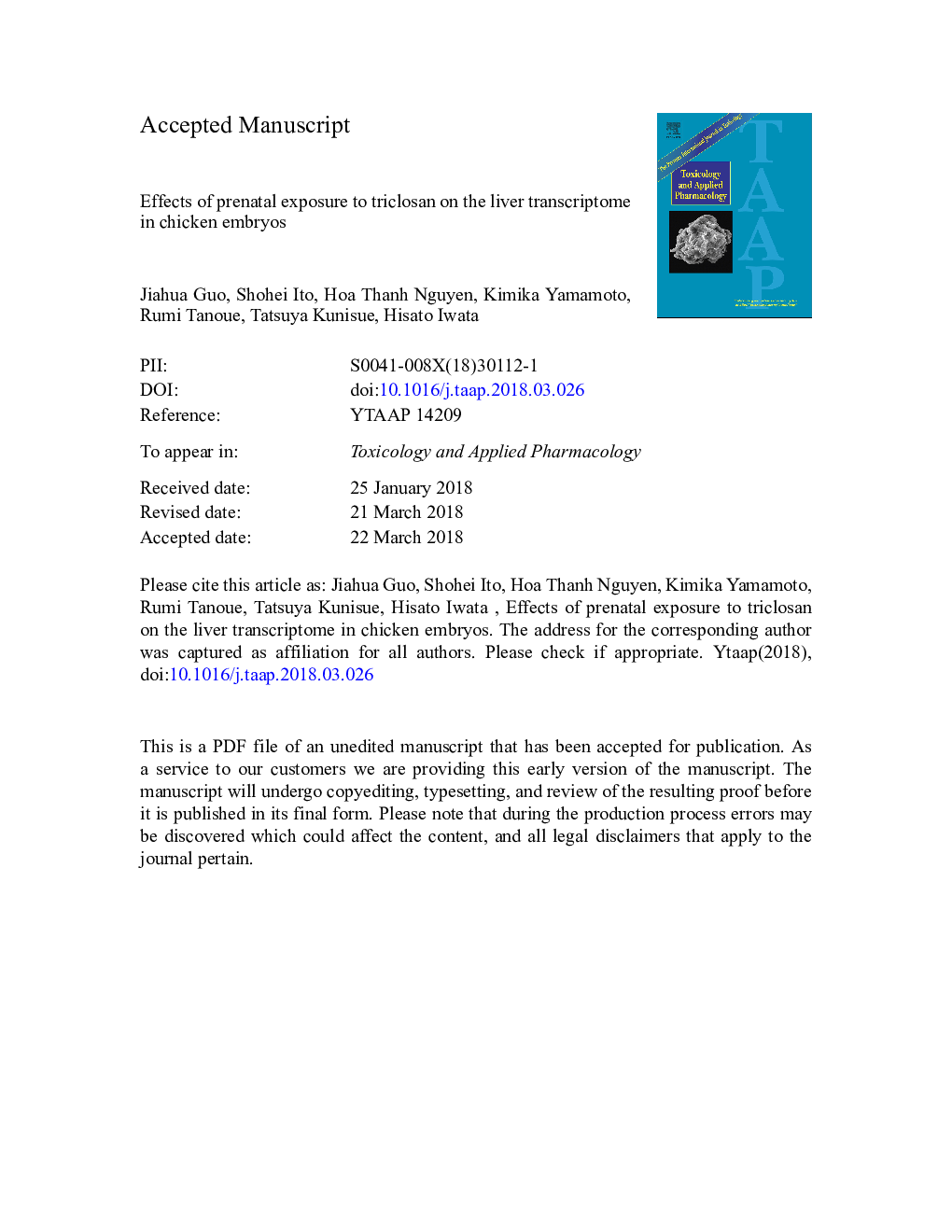| کد مقاله | کد نشریه | سال انتشار | مقاله انگلیسی | نسخه تمام متن |
|---|---|---|---|---|
| 8538597 | 1561115 | 2018 | 43 صفحه PDF | دانلود رایگان |
عنوان انگلیسی مقاله ISI
Effects of prenatal exposure to triclosan on the liver transcriptome in chicken embryos
ترجمه فارسی عنوان
اثرات حاملگی قبل از تولد به تریکلوسان بر روی ترانسکتوموم کبدی در جنین مرغ
دانلود مقاله + سفارش ترجمه
دانلود مقاله ISI انگلیسی
رایگان برای ایرانیان
کلمات کلیدی
تریکلوزان، جنین مرغ، ترانسکتیکوم مسیر معکوس، طول تارسس،
موضوعات مرتبط
علوم زیستی و بیوفناوری
علوم محیط زیست
بهداشت، سم شناسی و جهش زایی
چکیده انگلیسی
Triclosan (TCS), a commonly used antimicrobial compound, has recently been detected in the eggs of wild avian species. Exposure to TCS in rodents is known to interfere with thyroid hormone (TH), disrupt immune responses and cause liver disease. However, no attempt has been made to clarify the effects of TCS in avian species. The aim of this study is therefore to evaluate the toxic effects of in ovo exposure to TCS and explore the molecular mechanism by transcriptome analysis in the embryonic liver of a model avian species, chicken (Gallus gallus). Embryos were treated with graded concentration of TCS (0.1, 1 and 10â¯Î¼g/g egg) at Hamburger Hamilton Stage (HHS) 1 (1st day), followed by 20â¯days of incubation to HHS 46. At the administration of 10â¯Î¼g TCS/g egg, embryo mortality increased from 20% in control to 37% accompanied with 8% attenuation in tarsus length. While liver somatic index (LSI) in TCS treatments was enhanced, statistical difference was only observed at the treatment of 0.1â¯Î¼g TCS/g egg in females. The up-regulation of several crucial differentially expressed genes (DEGs) in transcriptome analysis suggested that TCS induced xenobiotic metabolism (e.g. CYP2C23a, CYP2C45 and CYP3A37 in males; CYP2C45 in females) and activated the thyroid hormone receptor (THR) - mediated downstream signaling (e.g. THRSPB and DIO2 in males; THRSPB in females). In females, TCS may further activate the lipogenesis signaling (e.g. ACSL5, ELOVL2) and repress the lipolysis signaling (e.g. ABHD5, ACAT2). A battery of enriched transcription factors in relation to these TCS-induced signaling and phenotypes were found, including activated SREBF1, PPARa, LXRa, and LXRb in males and activated GLI2 in females; COUP-TFII was predicted to be suppressed in both genders. Finally, we developed adverse outcome pathways (AOPs) that provide insights into the molecular mechanisms underlying the alteration of phenotypes.
ناشر
Database: Elsevier - ScienceDirect (ساینس دایرکت)
Journal: Toxicology and Applied Pharmacology - Volume 347, 15 May 2018, Pages 23-32
Journal: Toxicology and Applied Pharmacology - Volume 347, 15 May 2018, Pages 23-32
نویسندگان
Jiahua Guo, Shohei Ito, Hoa Thanh Nguyen, Kimika Yamamoto, Rumi Tanoue, Tatsuya Kunisue, Hisato Iwata,
